Yard art ideas – 12 ways to enhance your space with sculpture or artwork
Use these yard art ideas to add sculpture or artworks to your outdoor space and create stunning focal points


By adding backyard art ideas to your outdoor space you can create beautiful focal points that draw the eye to certain areas of your space. As backyards increasingly become extensions of our living spaces, look on the design of yours as you would an interior room, accessorizing it with sculptures or artworks as part of your backyard ideas.
There are many different options for styles, sizes or varieties of sculpture or artwork that you can use for garden decorating ideas and that can work with any type of backyard. Here, we show you some inspiring ideas, and how to style them.
Yard art ideas
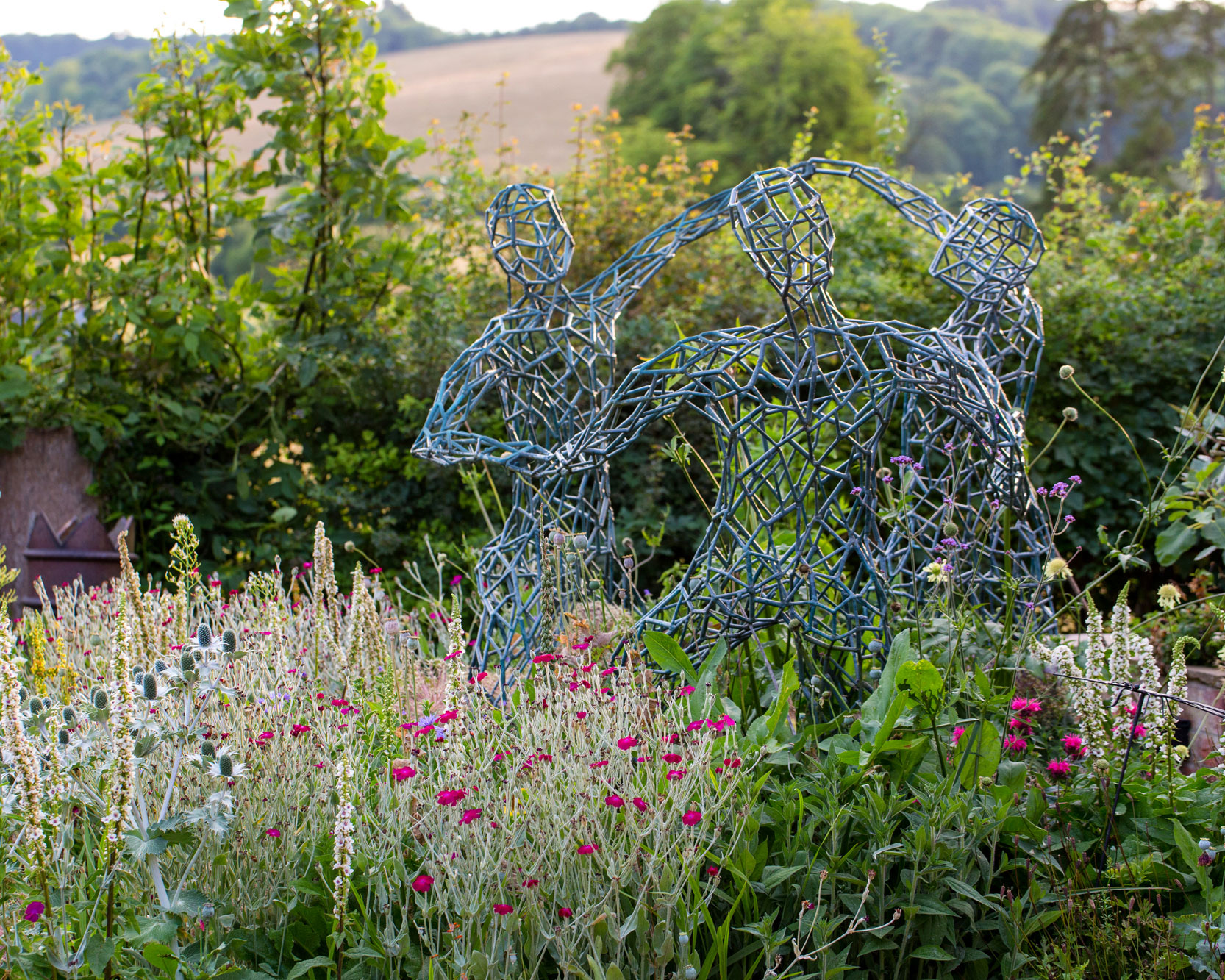
Before you commission a bespoke piece of sculpture or artwork or rush out to buy a piece, there are a number of factors to consider. Whether you are looking for a sleek contemporary design for an urban yard, a more traditional stone sculpture to complement a traditional English garden, or a rustic wooden piece for a cottage garden idea, choose one that suits your taste and the overall design of your backyard.
'Choosing sculpture and artworks is a deeply personal matter, but we advise clients to buy to create a memory, one that evokes a smile,' advises Rob Jones of The Garden Design Company.
'The positioning of your sculpture pieces will very much depend on the shape and size of your backyard. The amount of outdoor furniture, sculpture and hard landscaping elements will all determine where best to site your sculptural designs,' adds Nicola Clements of Haddonstone.
1. Add impact with yard art ideas

Consider the impact backyard art ideas may have on the overall design.
‘Sculptures or artworks can either harmonize with their immediate surroundings in tone, texture and form, or create a striking contrast,’ says sculptor David Harber.
Design expertise in your inbox – from inspiring decorating ideas and beautiful celebrity homes to practical gardening advice and shopping round-ups.
‘It should be the right scale and in proportion with the yard: too small it will get lost and too large it will dominate,’ adds award-winning garden designer Richard Miers.
Consider the height of sculpture, too. 'Should it be raised and viewed at eye level or from above – consider if a plinth is necessary to raise it from the ground,' advises garden designer Henrietta Murray-Wicks. 'It's important to think about how and when a sculpture or artwork will be viewed, as this will impact the scale of the piece to use. For instance will it mainly be seen from the house; from above, below or up close?' she adds.
Sculptures or artworks can be added to any size of backyard, including as small backyard ideas, so long as the scale and proportion are right.
'As with many things in life, form follows function, so consider carefully what the purpose of your garden sculpture is. Mostly sculpture is positioned to be easily and frequently viewed, so make sure that the chosen position delivers this. Consider viewing both from within the garden, and also from the house,' adds garden designer Peter Reader.
2. Provoke a reaction

Garden art ideas 'need to speak to you and provoke a reaction. Which comes first? Do you buy a piece you love and then find a suitable home for it in your garden, or do you find a suitable sculpture that fits a specific location? Both approaches are right, but most importantly you should love the piece,' explains Richard Miers.
For instance, Richard's award winning Perennial Garden design for Chelsea Flower Show 2022 included sculptures on the theme of love, including the sculpture pictured above by Tom Stogdon entitled ‘Connected’ – 'two half circles coming together, like a couple becoming one. The solidity of the material – stone and steel – indicating the solidity of the relationship,' explains Richard.
'Sculptures can be very different in the way they interact with both the viewer and the landscape, but it is always a piece of theatre. And like theater, it needs careful choreography and set design,' adds John Wyer, CEO and lead designer at Bowles & Wyer. 'Whether you start with the landscape or the sculpture, the most important consideration is make it very personal to you – as curiously it’s also then likely to make the biggest impression on others,' he adds.
3. Create a focal point

Used as a focal point, yard art ideas can draw attention and entice you into the garden and beyond.
'The pieces should be easily visible, a focal point, a pausing point or a full stop at the end of a garden path idea; they can be a destination,' explains Richard Miers.
'A piece can cause you to slow down, to reflect and admire, to walk around, to sit on, to touch and feel. At the same time the piece can frame a view or vista,' adds Rob Jones. They can add focus to a small garden or as courtyard garden idea, while acting as punctuation points in a larger garden.
'To achieve a balance between the garden and your indoor space, consider placing a sculpture on a long axis visible from a prominent window or directly in front of a window or door,' advises stonebalancing sculptor Adrian Gray.
'Multiple view points and journeys within a garden can make it into a magical place and sculpture can be cleverly used not just as a thing of beauty in itself, but as disguised sign-posting,' says Peter Reader.
As a narrow garden idea, 'planting can be used to trick the eye to create a more dramatic effect. A sculpture placed at the end of a narrow lawn, where the hedges subtly get closer together the further away you go, creates a false perspective that makes the sculpture look further away, and therefore the garden feels bigger than it really is,' explains Peter.
4. Suit the sculpture to the location

When incorporating yard art ideas, 'think about your wider garden design and place the piece in an area that generates "flow",' advises Adrian Gray.
'For example, a restful glade would suit a contemplative and calming sculpture, whereas a focal point or the head of a long view would better suit a more powerful and majestic sculpture. Of course, you’ll need to carefully consider the design, too,' adds John Wyer.
Setting has a great influence. 'A driftwood sculpture may look perfectly at home in a coastal garden idea, but in a city, less so. For our part we also observe what is already in the house or garden to provide clues as to what will work,’ says Rob Jones.
5. Elicit different moods with garden art
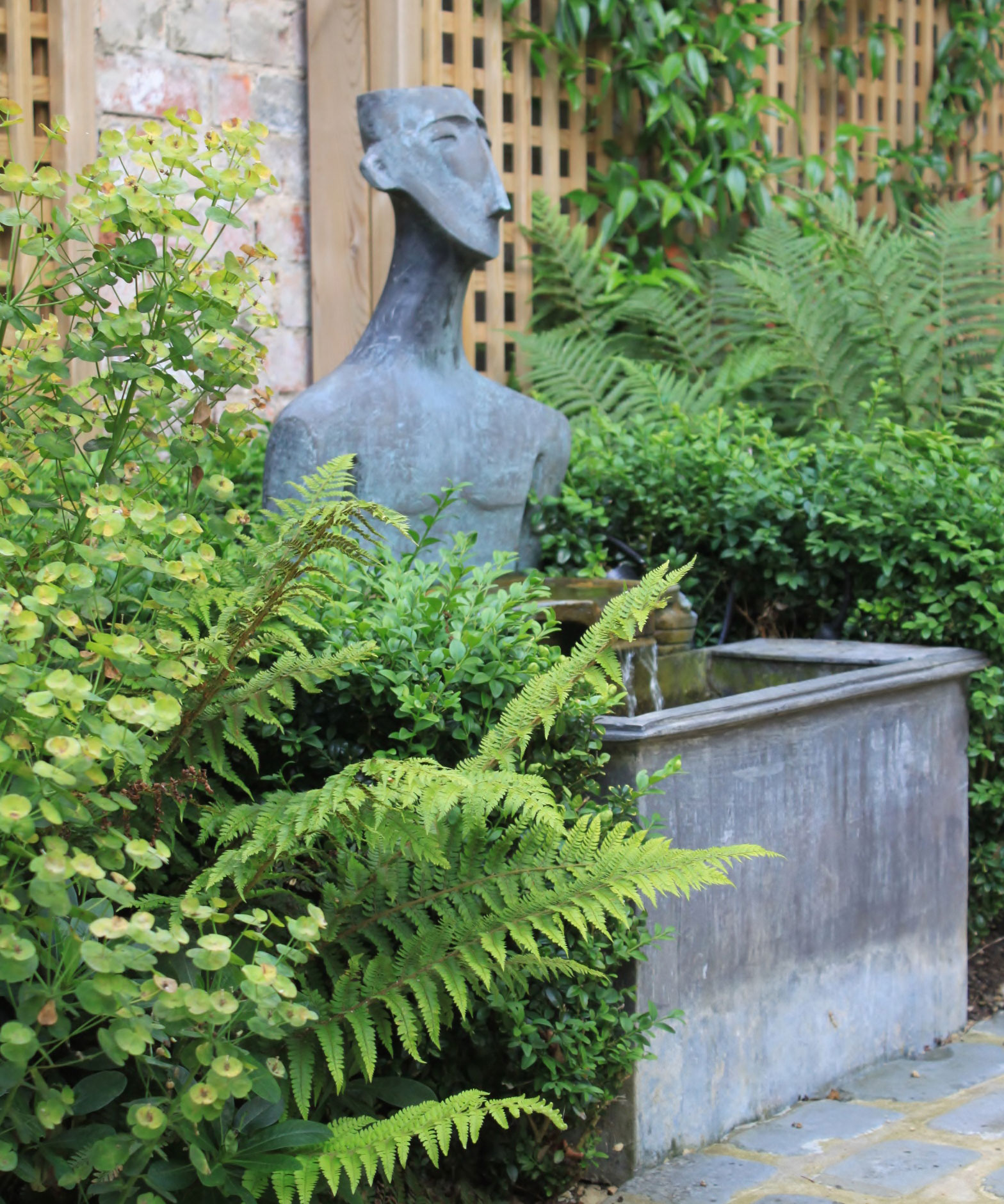
'Different areas of your backyard will generate different feelings. Choosing the best place for your sculpture will help promote particular emotions and draw your eye into specific areas. Placing a sculpture in a wide-open space can elicit feelings of euphoria and freedom from care. Whereas, pieces placed in a smaller cosier area, help to communicate feelings of safety and nurturing,' explains Adrian Gray.
In this backyard design by Peter Reader Landscapes a bronze figurative sculpture is combined with a water feature idea to promote a feeling of calm and relaxation.
6. Choose a practical material
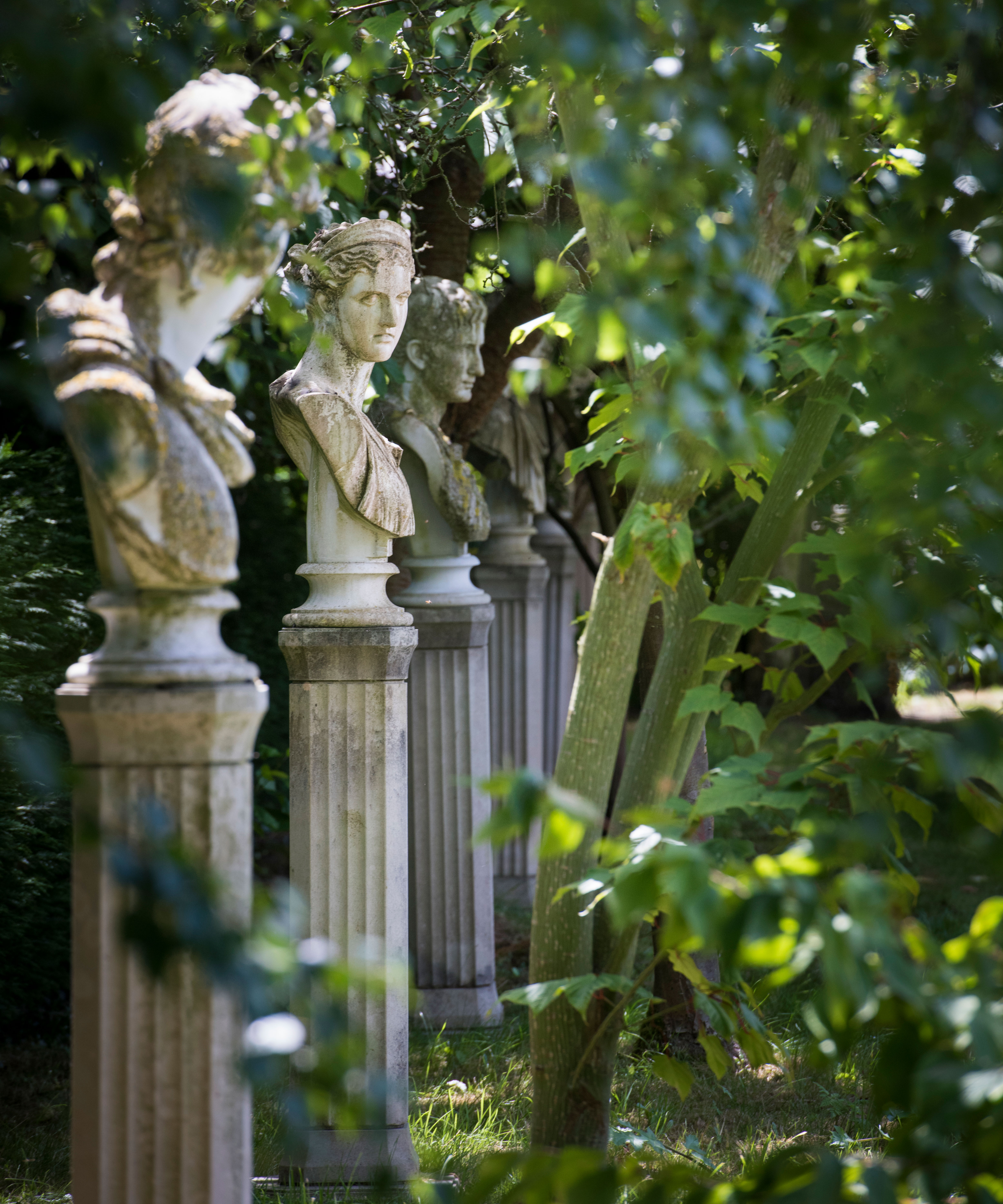
The material of yard art ideas should be practical for life outdoors. ‘Wooden pieces may age quickly, gathering moss and lichen; stone may discolor; glass and ceramics are lighter, but are they frost and theft proof? Consider how unique and valuable pieces will be secured and check the household insurance,’ advises Rob Jones of The Garden Design Company.
Cast and natural stone are both traditional materials that can also work well in contemporary yard settings. 'Cast stone weathers beautifully over time – the amount of time the process takes depends on where you locate your sculpture. It is also long-lasting and frost-resistant, so you can be assured that it will weather even the harshest conditions during winter,' says Nicola Clements of Haddonstone.
7. Plan the planting

Planting surrounding backyard art ‘should be kept simple, so the art isn’t fighting the planting,’ says Richard Miers. ‘A yew hedge, for instance will provide a subtle backdrop to allow the sculpture to sing.'
Think about the scale and color of surrounding foliage and flowers – do you want a piece to complement or stand out from the surrounding planting?
'Use evergreen shrubs and perennials that are either in harmony with the sculpture or of a contrasting nature. Stainless steel works well with deep purple alliums, Actaea atropuprea or salvias, while large leafed gunneras will help sculptures emerge from the landscape with grasses anchoring them,' says Rob Jones.
'For more natural sculptures, they are often best set low to the ground, surrounded by naturalistic planting design. Larger and more commanding pieces need a more formalised setting, surrounded by formal flower bed ideas,' says John Wyer.
Leaf color and texture can have a huge impact as to how successfully a sculpture sits in its surroundings. 'If you are using a dark sculpture, such as a deep bronze color, it's best to avoid a dark background, so the sculpture doesn't get lost when viewed from far away,' says Henrietta Murray-Wicks.
'Also consider whether the garden sculpture is something that will be viewed best in summer, surrounded by foliage or is it for fall or winter interest when peak flowering season is over,' Henrietta adds.
Some sculptures can provide support for plants, while 'underplanting offers a clever way to use any un-used space around your sculpture. Siting stone statues in shadier spots and under trees will speed up the weathering process,' adds Nicola Clements.
8. Create an element of surprise
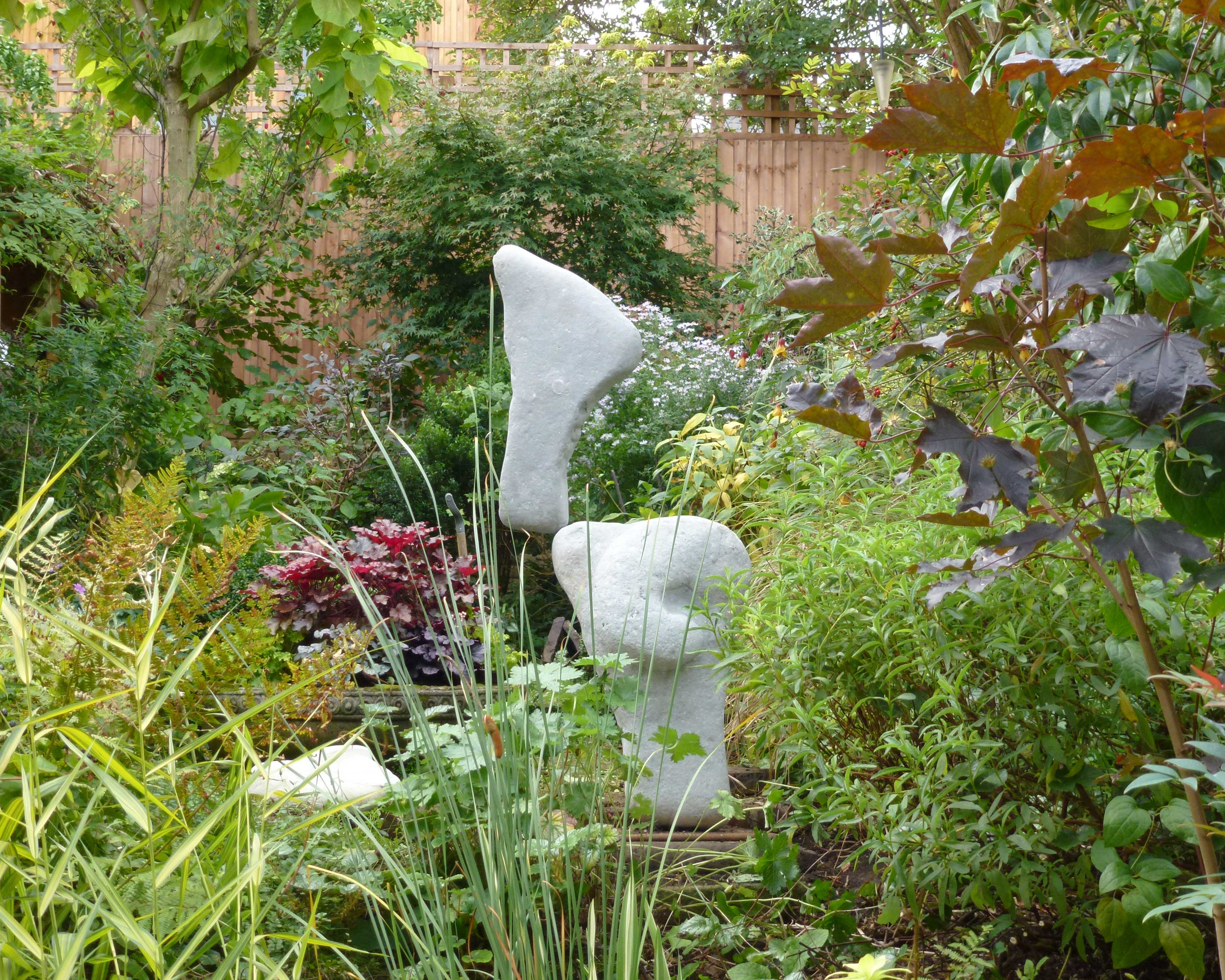
While with some yard art ideas you will be looking to create a strong focal point, with others you may want to introduce an element of surprise as you walk through the space.
In this backyard a distinctive and tactile stone balanced sculpture by Adrain Gray is nestled among the planting, revealing itself when you look into the garden border.
'More figurative art, such as of animals, can look best when placed in a wildflower meadow where glimpses can be caught but they aren’t too obvious,' says Richard Miers.
'With a number of new materials available for hardscapes, sculpture can be more subtle and can blend with planting or help provide mystery and direction through the space. A good example of this is the current popularity of laser cut metal screens as garden screening ideas, which can deliver both an artistic statement and a practical function,' says Peter Reader.
9. Appeal to the senses with tactile sculptures
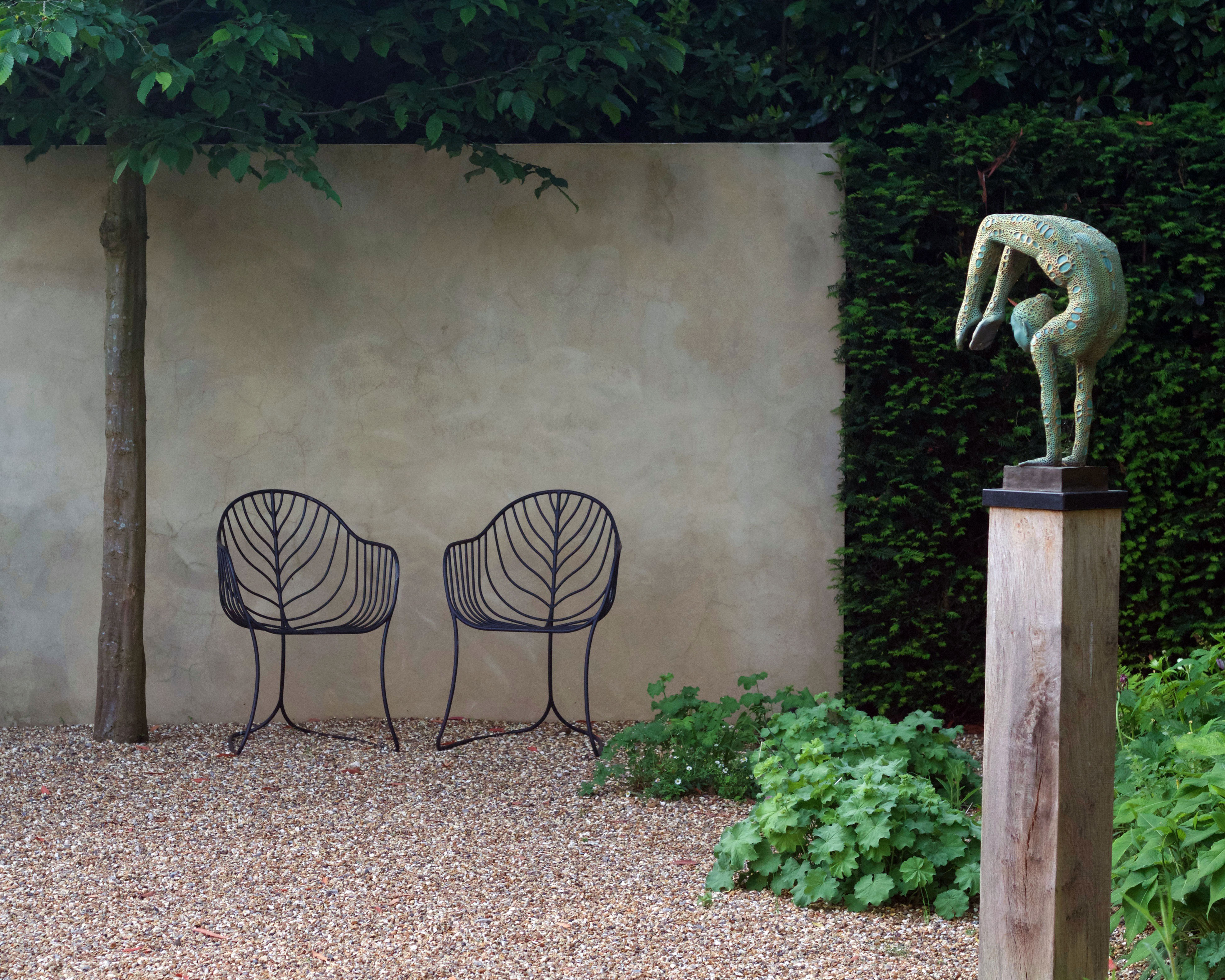
'I love using garden sculpture pieces that are very tactile and make you want to touch them – especially as this can change with the seasons. This could either be natural materials, such as oak, or the likes of Corten steel, which has such a warmth too it in both color and texture,' says Henrietta Murray-Wilkes.
The naturally aged patina on the bare rendered garden wall idea above enhances it as a backdrop for the tactile sculpture in this backyard design by Henrietta.
'Consider how sunlight and even moonlight can affect the ambience of the sculpture, casting shadows and with textures changing depending on time of day,' adds Rob Jones.
10. Use lighting
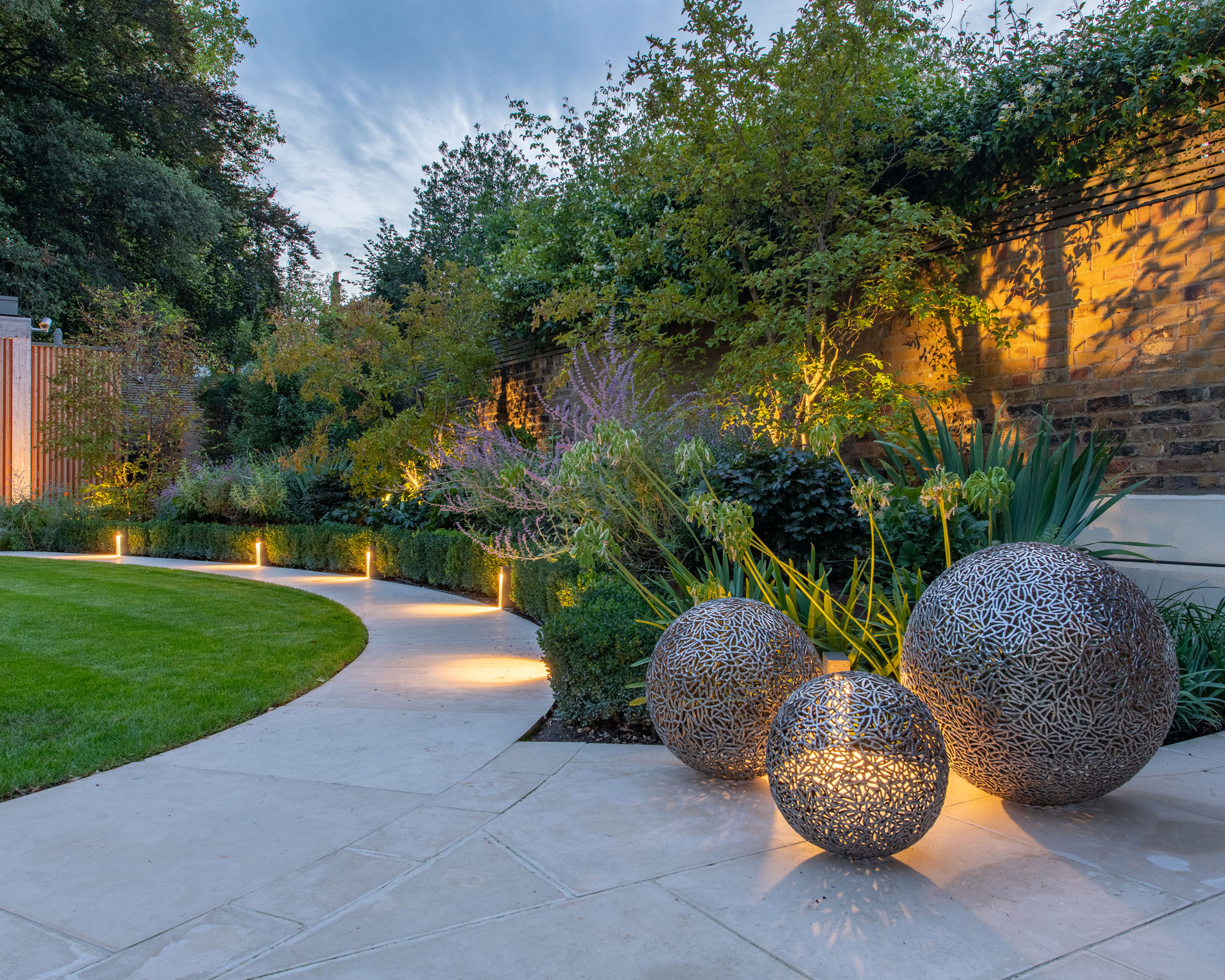
Lighting of yard art ideas is key. In this garden design by Bowles & Wyer, sculptural metal spheres have been subtly lit with outdoor lighting ideas to draw attention to them at nighttime.
'Think about the shadows or areas of shade on the garden sculpture and how best to view the piece – either lit naturally or by spot lights. Sometimes speaking to the artist or gallery directly can really help guide you as to how the artist wanted the piece to be seen,' explains Henrietta Murray-Wicks.
'Don’t forget about evening and night options, and place your sculpture where it can be lit well, usually from an angle below,' adds Peter Reader.
'Think, too, about how the sunlight will look on the sculpture, and how throughout the course of the day this will change, as this is also an important factor in how much, or how little, of a statement the sculpture makes,' adds David Harber.
11. Choose ease of maintenance
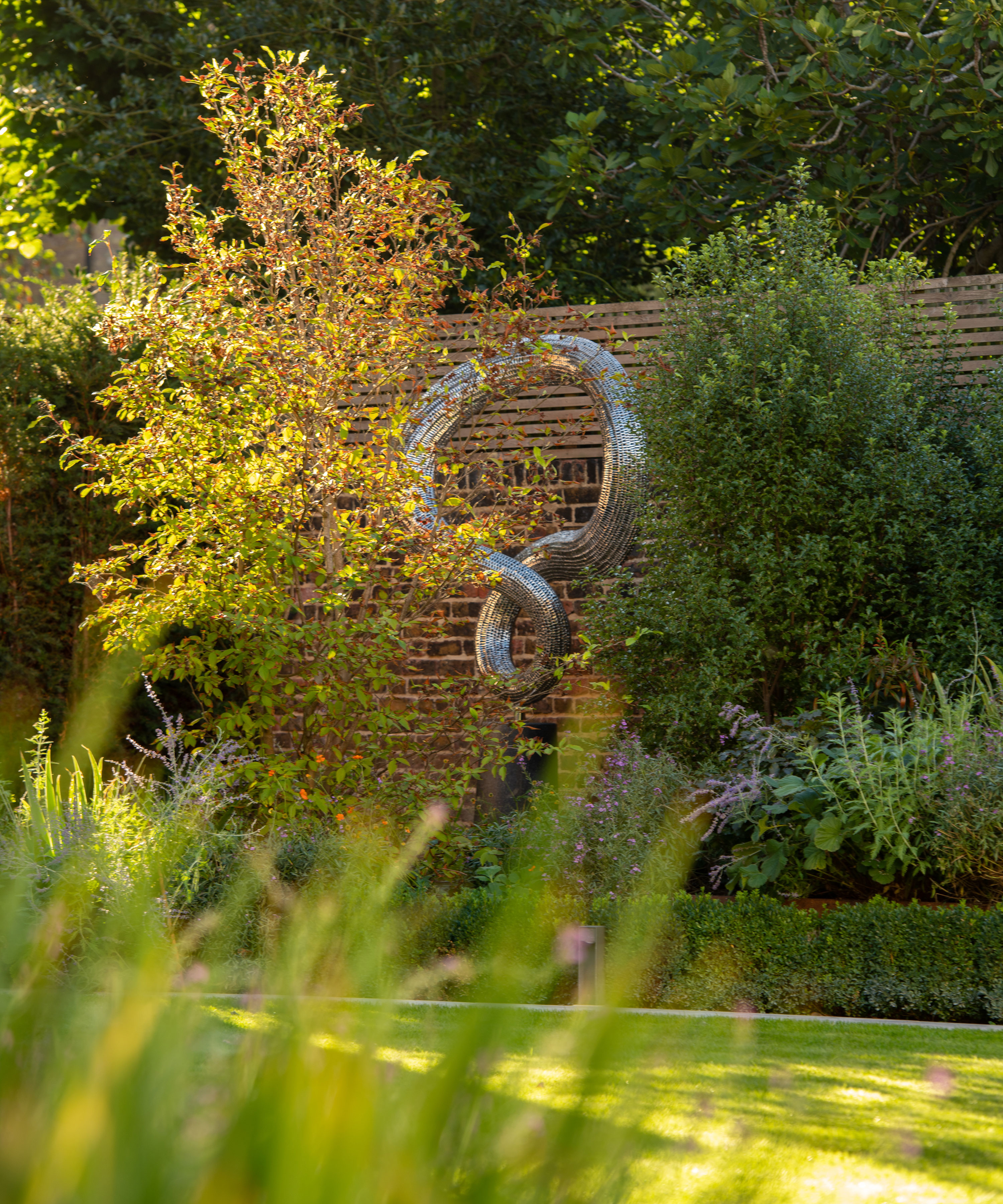
Consider what care and maintenance of the backyard sculpture or artwork will be required and if this is manageable. 'Try to avoid anything that will date whether in terms of style or color. Sculpture should ooze longevity as well as beauty,' says Rob Jones.
This beautiful sinuous metal sculpture in a garden design by Bowles & Wyer is both easy to maintain and has a wonderfully timeless feel that can suit both a traditional and contemporary garden setting.
'Unruly plants that are difficult to access or maintain can swamp a sculpture and hide it from view, so consider maintenance of the sculpture and its desired effect as well in the planning,' adds Peter Reader.
Materials such as cast stone and metal are strong and durable and will need little looking after. Consider, however, that they will weather and develop a patina over time.
'Before undertaking any cleaning it is worth considering that, like natural stone, cast stone weathers differently depending on where it is located and how long it has been exposed to the elements. For example, if the front aspect of garden feature idea is in direct sunlight for the majority of the year and the back is mainly shaded, both will weather inconsistently and any cleaning will only enhance that contrast,' explains Nicola Clements.
12. Take inspiration from sculpture parks
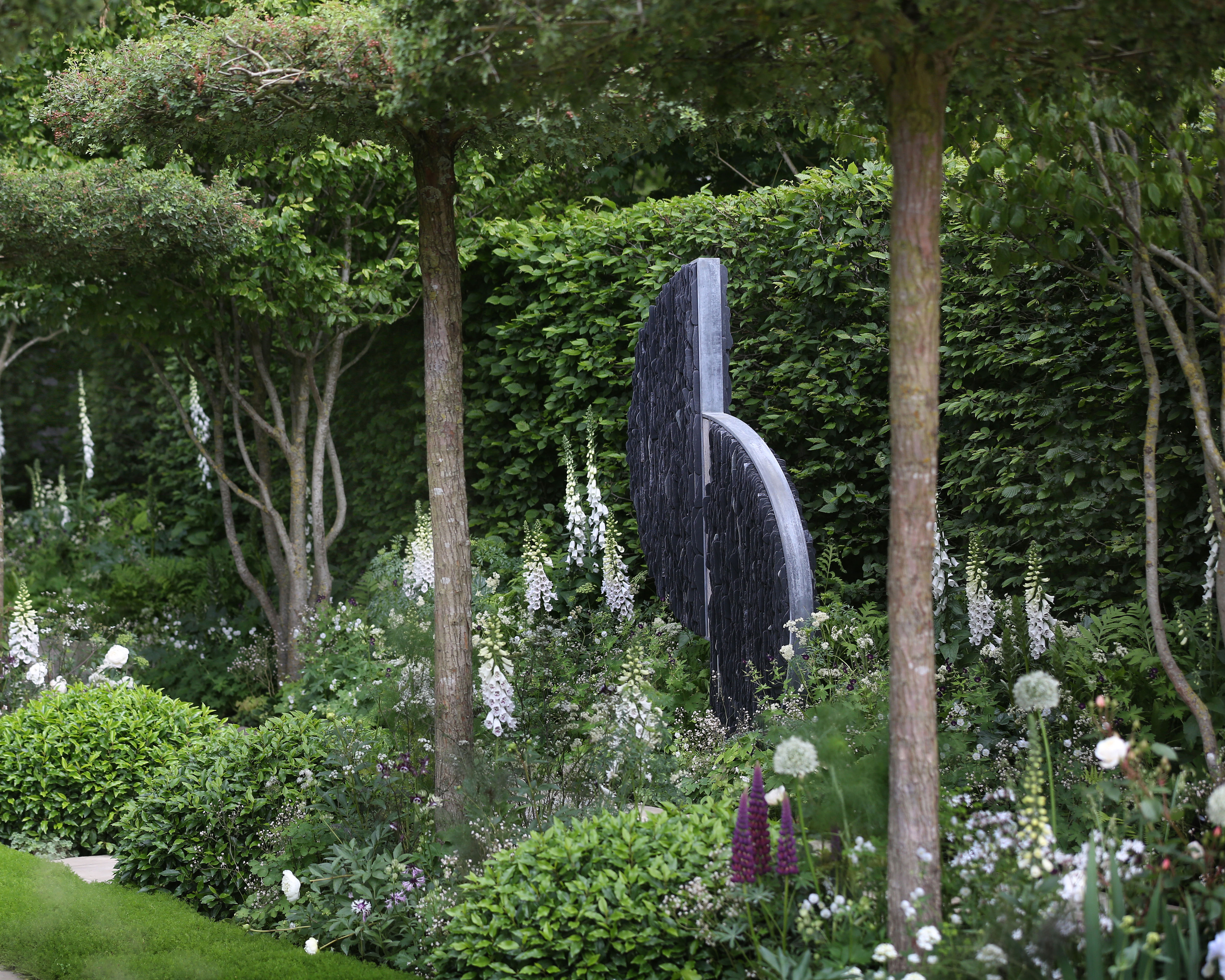
Visiting sculpture parks, online or in person, is really helpful to see how they sit their pieces in a garden setting and how much space is left around the pieces,' says Henrietta.
'Visits to sculpture parks with the client can often evoke responses – both positive and negative – that help guide,' agrees Rob Jones.
'There is a reason sculptures work so well in outdoor spaces. You only need to look at famous sculpture gardens to see how sculptures provide a natural and beautiful foil to plants – helping to both set them off and separate a garden into different and distinct zones,' adds Adrian Gray.
How can art make my backyard more interesting?
You can instantly make your garden more interesting by adding backyard art, such as a sculpture.
However, beware of pastiche. 'Some sculptures very strongly suggest a certain theme; like a figurine of Pan, delivers an Italianate feel and so use them with caution and avoid pastiche. Similarly objects that are very clearly of a certain era can be problematic if that fashion falls away and leaves the sculpture looking jaded. This is not a hard and fast rule though, as these objects can also become classics and develop a timelessness about them,' says Peter Reader.
Rachel is senior content editor, and writes gardening content for homesandgardens.com, Homes & Gardens magazine, and its sister titles Period Living Magazine and Country Homes & Interiors. She has written for lifestyle magazines for many years, with a particular focus on gardening, historic houses and arts and crafts, but started out her journalism career in BBC radio, where she enjoyed reporting on and writing programme scripts for all manner of stories. Rachel then moved into regional lifestyle magazines, where the topics she wrote about, and people she interviewed, were as varied and eclectic as they were on radio. Always harboring a passion for homes and gardens, she jumped at the opportunity to work on The English Home and The English Garden magazines for a number of years, before joining the Period Living team.
